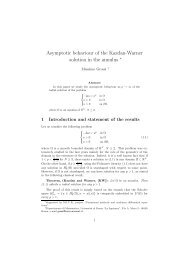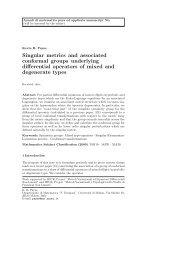Degree of Parabolic Quantum Groups - Dipartimento di Matematica ...
Degree of Parabolic Quantum Groups - Dipartimento di Matematica ...
Degree of Parabolic Quantum Groups - Dipartimento di Matematica ...
Create successful ePaper yourself
Turn your PDF publications into a flip-book with our unique Google optimized e-Paper software.
4. General Theory 41<br />
4.2.1 The center <strong>of</strong> Uǫ<br />
The center <strong>of</strong> Uǫ consists <strong>of</strong> “two parts”, one coming from the center at a<br />
“generic q”, the other from the fact that ǫ is a root <strong>of</strong> 1. We begin by<br />
describing the center at “q generic”.<br />
Let Z be the center <strong>of</strong> U. Any element z ∈ Z can be written as a linear<br />
combinations <strong>of</strong> the elements <strong>of</strong> the basis <strong>of</strong> U given by the P.B.W. theorem.<br />
Since z commutes with the Ki for all i, it follows that<br />
z = <br />
<br />
η∈Q + r,t∈Par(η)<br />
E r ϕr,tF t<br />
where ϕr,t ∈ U0 and<br />
<br />
Par(η) = (m1, . . .,mN) ∈ N N : <br />
<br />
miαi = η .<br />
Definition 4.2.5. The map h : Z ↦→ U 0 defined by h(z) = ϕ0,0 is called the<br />
Harish Chandra homomorphism<br />
Property. h is a homomorphism <strong>of</strong> algebras.<br />
Pro<strong>of</strong>. See [DCP93], §18.<br />
h allows us to describe Z as a ring. Any element φ ∈ U0 may be regarded<br />
as a C(q)-valued function on the weight lattice Λ in an obvious way: if<br />
φ = n i=1 Kti<br />
i , where ti ∈ Z for all i, set ∀ λ ∈ Λ<br />
φ(λ) = qÈi ti(αi|λ)<br />
and extended to U 0 by linearity. Define an automorphism <strong>of</strong> C(q)-algebras<br />
γ : U 0 ↦→ U 0 by setting γ(Ki) = qiKi. Then<br />
Property. For all φ ∈ U 0<br />
where ρ = 1<br />
2 (α1 + . . . + αn).<br />
γ(φ)(λ) = φ(λ + ρ)<br />
Let Q ∗ 2 = {σ : Q ↦→ Z2}, it is easy to see that Q ∗ 2<br />
automorphisms by<br />
i<br />
acts on U as a group <strong>of</strong><br />
σ · Kβ = σ(β)Kβ (4.11)<br />
σ · Fα = σ(α)Fα (4.12)<br />
σ · Eα = Eα (4.13)<br />
for all α ∈ R + , β ∈ Q, and σ ∈ Q ∗ 2 . Note that W acts on Q∗ 2 :<br />
(ω · σ)(β) = σ(ω −1 (β));








